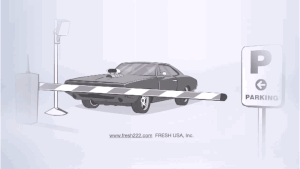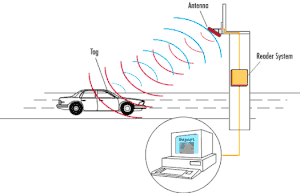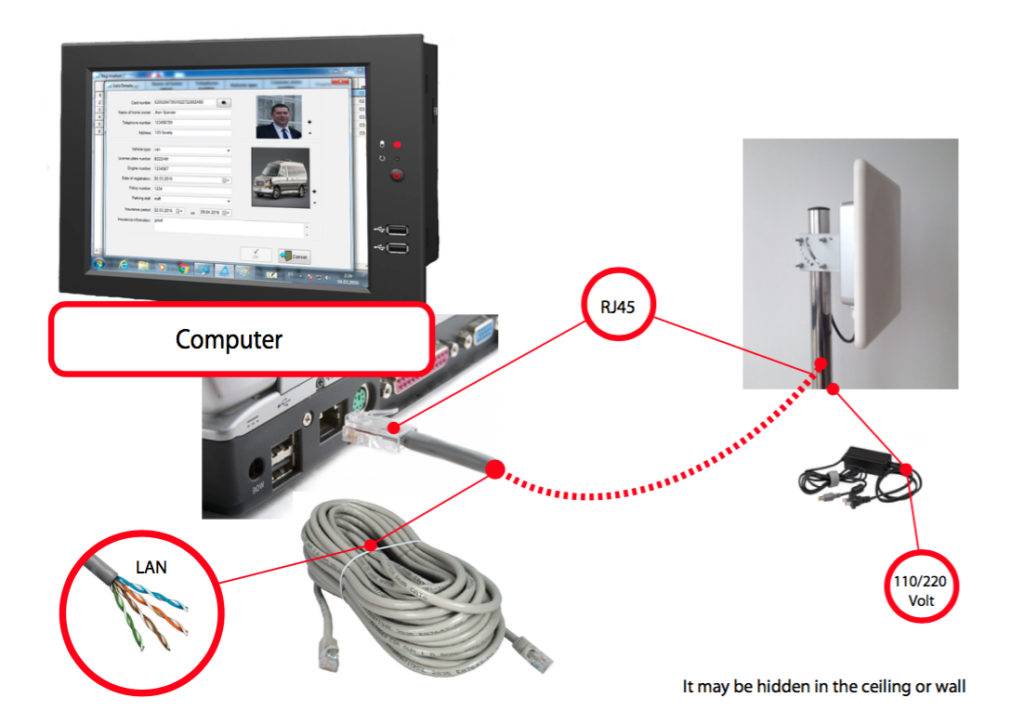An RFID vehicle access control system is a specific type of RFID UHF (Ultra High Frequency) system that operates at higher frequencies, typically in the range of 860 to 960 MHz. This technology is specifically designed for vehicle access control and offers distinct advantages over other RFID systems.
RFID Vehicle Access Control: A Comprehensive Guide
At our Fresh USA company, we understand the significance of efficient and secure vehicle access control systems. In this comprehensive guide, we delve into the world of RFID (Radio Frequency Identification) technology and its role in revolutionizing vehicle access control. With our expertise in the field, we aim to provide you with valuable insights and knowledge that will help you make informed decisions for your organization’s access control needs.
Free Online Estimate of Parking Access Control Systems
PRICE / Buy Access Control System, range 26ft / 8m
PRICE / Buy Access Control System, range 49ft / 15m
Introduction to RFID Vehicle Access Control
RFID technology has emerged as a game-changer in the realm of vehicle access control. With its ability to wirelessly transmit data, RFID offers seamless and reliable identification solutions, enhancing security, convenience, and operational efficiency. Unlike traditional access control methods such as physical keys or swipe cards, RFID provides a contactless means of granting access, making it more user-friendly and reducing the risk of unauthorized entry.


How RFID Vehicle Access Control Works
At the core of RFID vehicle access control is the RFID tag, which consists of an integrated circuit and an antenna. The tag is affixed to a vehicle, typically on the windshield or license plate, and contains unique identification data. When the vehicle approaches an RFID reader installed at a controlled access point, the reader emits a radio signal that activates the tag. The tag responds by transmitting its stored information back to the reader, enabling quick and accurate identification.
Advantages of RFID Vehicle Access Control
-

vehicle access control solutions RFID Enhanced Security: RFID technology provides a higher level of security compared to traditional access control methods. The unique identification codes of RFID tags make it extremely difficult to clone or counterfeit, reducing the risk of unauthorized access.
- Convenience and Efficiency: With RFID vehicle access control, drivers no longer need to manually present cards or use physical keys to gain entry. The contactless nature of RFID streamlines the process, improving traffic flow and reducing waiting times at access points.
- Data Capture and Analytics: RFID systems can collect valuable data on vehicle movements, entry times, and more. This data can be leveraged for various purposes, including traffic analysis, optimizing access control procedures, and generating insights for operational improvements.
- Integration Capabilities: RFID technology seamlessly integrates with other systems, such as parking management or security systems, allowing for centralized control and increased operational efficiency.
Types of RFID Vehicle Access Control Systems
-
-

RFID Vehicle Access Control Sticker Passive RFID Systems: In passive RFID systems, the RFID tag does not have an internal power source. Instead, it relies on the energy emitted by the reader to activate and transmit data. Passive RFID systems are cost-effective and suitable for various access control scenarios.
- Active RFID Systems: Active RFID systems utilize tags with built-in power sources, such as batteries. These tags can transmit signals over longer distances and offer increased read ranges. Active RFID systems are often used in applications where real-time monitoring and tracking of vehicles are required.
- Hybrid RFID Systems: Hybrid systems combine the benefits of both passive and active RFID technologies. They are versatile and can be customized to meet specific access control requirements. Hybrid systems are particularly useful in environments where vehicles may operate both in close proximity and at a distance from readers.
-
PRICE / Buy Access Control System, range 26ft / 8m
PRICE / Buy Access Control System, range 49ft / 15m
Implementing RFID Vehicle Access Control
To implement an effective RFID vehicle access control system, several key considerations should be taken into account:
-
-
- Site Assessment: Conduct a thorough assessment of the site to determine the number and optimal locations for RFID readers. Consider factors such as entry points, traffic flow, and any potential obstacles that could affect signal transmission.
- Tag Selection: Choose RFID tags that are suitable for your specific application. Factors such as read range, durability, and attachment methods should be considered when selecting tags.
- Reader Placement: Strategically position RFID readers to ensure maximum coverage and reliable tag detection. Consider the height, angle, and orientation of the readers for optimal performance.
- Integration and Scalability: Ensure that the RFID vehicle access control system can integrate with existing systems and is scalable to accommodate future expansions or modifications.
-
Conclusion
RFID vehicle access control systems offer a reliable, secure, and convenient solution for managing vehicle entry and enhancing overall security. With its ability to streamline access procedures, provide valuable data insights, and integrate with other systems, RFID technology has become a cornerstone of modern access control strategies. By implementing an RFID vehicle access control system tailored to your organization’s needs, you can optimize operational efficiency, improve security, and stay ahead in today’s dynamic world.
Use of Long-Range Wireless Technologies In Vehicle Access Control Systems

RFID vehicle access control systems manufactured by FRESH USA have been tested for many years of use around the world and work perfectly in all weather conditions. Our systems use only contactless technologies such as Wi-Fi, 4G / LTE, and RFID UHF long range distance with a frequency of 860MHz – 960MHz. You can integrate the parking management software with other third-party software or your ERP system using a SQL database or deploy a Web-service.
Any RFID system, from Fresh USA is Your reliable choice.
The main advantage of a Vehicle Access Control System with RFID UHF technology is the high read range, which allows for efficient and convenient access control of vehicles without the need for physical contact or line-of-sight communication.
At our Fresh USA company, we specialize in delivering comprehensive and innovative RFID vehicle access control solutions. Contact us today to learn how we can help you implement a cutting-edge access control system that meets your unique requirements and surpasses your expectations.

Chicago RFID Vehicle Access Control Systems
RFID Vehicle Access Control Systems: Revolutionizing Access Management
In an increasingly connected world, managing vehicle access efficiently and securely is paramount. RFID (Radio-Frequency Identification) technology has emerged as a game-changer in this regard, offering innovative solutions for vehicle access control systems. In this article, we’ll explore the significance, workings, components, types, benefits, implementation, and future trends of RFID vehicle access control systems.
Understanding RFID Technology
RFID technology utilizes radio waves to identify and track objects. It consists of three main components: RFID tags, readers, and control panels. When an RFID tag comes into range of an RFID reader, it transmits its unique identification information, enabling quick and accurate identification.
Components of RFID Vehicle Access Control Systems
RFID vehicle access control systems comprise RFID tags installed on vehicles, RFID readers positioned at entry and exit points, and control panels that manage access permissions and data.
Types of RFID Vehicle Access Control Systems
There are two main types of RFID systems used in vehicle access control:
Passive RFID Systems
Passive RFID systems rely on the energy emitted by RFID readers to power the RFID tags. These systems are cost-effective and suitable for short-range applications.
Active RFID Systems
Active RFID systems feature battery-powered RFID tags that transmit signals independently of RFID readers. These systems offer longer read ranges and are ideal for large-scale applications.
Benefits of RFID Vehicle Access Control Systems
RFID vehicle access control systems offer a host of benefits for both facility operators and users.
Enhanced Security
By providing secure, automated access control, RFID systems prevent unauthorized entry and ensure only authorized vehicles gain access.
Improved Efficiency
Automated entry and exit processes streamline vehicle flow, reduce congestion, and minimize wait times, thus enhancing operational efficiency.
Convenience and Flexibility
RFID systems offer convenient and flexible access management options, such as remote access control and customizable access permissions.
Implementation and Integration
Implementing RFID vehicle access control systems requires careful planning and consideration of various factors.
Installation Process
The installation process involves positioning RFID readers strategically at entry and exit points, installing RFID tags on vehicles, and configuring control panels for access management.
Integration with Other Systems
RFID systems can be seamlessly integrated with other technologies such as surveillance cameras, payment systems, and vehicle counting sensors to enhance functionality and interoperability.
Use Cases and Applications
RFID vehicle access control systems find applications across various sectors and industries.
Parking Facilities
In parking facilities, RFID systems manage access control, track vehicle movements, and optimize parking space utilization.
Gated Communities
In gated communities, RFID systems enhance security by ensuring only authorized vehicles gain entry.
Industrial Facilities
In industrial facilities, RFID systems regulate access to restricted areas, improving security and safety measures.
Future Trends in RFID Vehicle Access Control Systems
As technology continues to evolve, RFID vehicle access control systems are expected to undergo further advancements and innovations.
Advancements in Technology
Emerging technologies such as AI, machine learning, and IoT are driving innovations in RFID systems, enabling predictive analytics, autonomous vehicle recognition, and enhanced security features.
Integration with Smart Cities
RFID systems are increasingly being integrated into smart city initiatives, enabling seamless connectivity and interoperability with other urban infrastructure.
Conclusion
RFID vehicle access control systems represent a significant advancement in access management technology, offering enhanced security, improved efficiency, and convenience for users. As the demand for smart access solutions continues to grow, RFID systems will play a crucial role in shaping the future of access control in various settings.
FAQs (Frequently Asked Questions)
- How does RFID technology work in vehicle access control systems?
- RFID technology utilizes radio waves to identify and track vehicles, with RFID tags transmitting unique identification information to RFID readers for quick and accurate identification.
- What are the main benefits of RFID vehicle access control systems?
- RFID systems offer enhanced security, improved efficiency, and convenience for users by providing secure, automated access control and streamlining vehicle flow.
- What types of RFID systems are used in vehicle access control?
- There are two main types: passive RFID systems, which rely on RFID readers to power RFID tags, and active RFID systems, which feature battery-powered RFID tags that transmit signals independently.
- How are RFID vehicle access control systems implemented and integrated?
- Implementation involves strategically positioning RFID readers, installing RFID tags on vehicles, and configuring control panels for access management. RFID systems can be seamlessly integrated with other technologies such as surveillance cameras and payment systems.
- What are the future trends in RFID vehicle access control systems?
- Future trends include advancements in technology such as AI, machine learning, and IoT, as well as integration with smart city initiatives to enable seamless connectivity and interoperability.






